Each season, it seems San Jose Sharks head coach Peter DeBoer has done a good job. And each would have been very good had he avoided making one key mistake.
In his first season with the Sharks, he coached the team to the Stanley Cup Final. There, against a speedy Pittsburgh Penguins team, he kept together the very slow defensive pair of Roman Polak and Brenden Dillon. Key mistake #1. The Pens’ fast forecheckers exploited the pair, leading to victory in the series.
The next season, DeBoer said he understood the challenge the Sharks faced from a short offseason, players participating in the World Cup of Hockey, an older roster and a compressed schedule. But he didn’t. Key mistake #2. The team, in DeBoer’s own words “ran out of gas” in March because he refused to cut back on the playing time for top players. As a result, they had little left late in the season. Brent Burns, in particular, hit a wall. He won the Norris Trophy, but his play dropped like a rock in the season’s final month. A burned out and beat up Sharks team lost in the opening round.
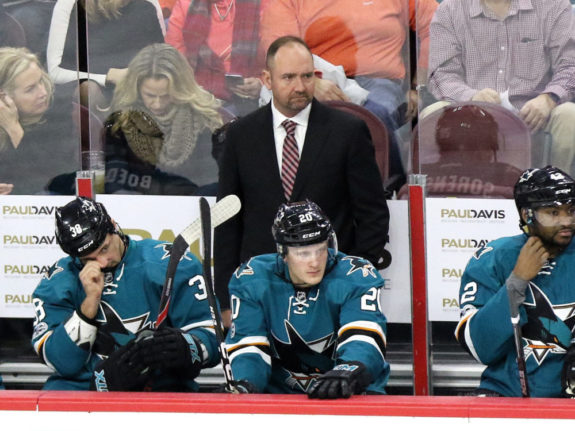
Last season, DeBoer’s team swept their opening round playoff series. Before the next round, he was asked about playing slower and older defenseman Paul Martin against a very quick Vegas Golden Knights team. DeBoer said he’d ‘be an idiot’ to change his defenders. Mistake #3. In Game 3 of the series, Martin played only 10 minutes while his partner played 37. The pairing got burned in overtime for the series-changing game-winning goal.
The Sharks Objective
This is DeBoer’s fourth season in San Jose. His roster is among the healthiest and most talented in the league. The team is in a daily battle with the Calgary Flames for the best record in the Pacific Division and Western Conference. The Sharks have essentially clinched a playoff spot. But make no mistake, for San Jose, this season is only about what happens in the playoffs. It is the Stanley Cup or bust.
Repeating History
One mistake DeBoer seems determined to repeat is pushing hard to post the best regular-season record in the Pacific Division. History says – rather history screams – the best record in the Pacific Division is meaningless when it comes to the playoff success. Over the last decade, the most playoff success has actually come from teams finishing third in the Pacific Division.
Across the league, playoff success doesn’t correlate with regular-season standings. Pursuit of meaningless goals can risk bigger objectives. Or in the Sharks’ case, risk the one objective which dwarfs all others.
Sharks’ Defensive Pairs
The Sharks’ best defensive pairing this season is Erik Karlsson with Dillon. Starting in early December, the pairing was the best in hockey. Dillon and Karlsson each posted a plus-20 rating (with Karlsson tallying 27 points!) and the Sharks sizzled to the tune of a 16-3-2 record over the next six weeks. The torrid streak ended with Karlsson’s injury in mid-January.
The Dillon-Karlsson pairing dominated. For the season, the pairing has a Corsi for, Fenwick for and goals for of over 60 percent in each category.

Karlsson returned from injury for the Saturday tilt against the Vancouver Canucks. And immediately upon his return to the lineup, DeBoer went with the pairing of Karlsson and Marc-Edouard Vlasic, Karlsson’s partner at the start of the season.
I’m not sure how to make sense of this. How does one decide to break up the league’s best pairing? And how would one know if the change worked? To equal the Karlsson-Dillon pairing, the Karlsson-Vlasic pairing would need to average at least plus-one (each) per game. Which is a staggering pace (the league’s best is plus-30, roughly half the pace Dillon-Karlsson achieved).
The move also bumped Dillon down to the third pairing. Against the Canucks, he posted a meager 14 minutes of ice time, fifth among Sharks defensemen. Fourth in ice time was Justin Braun, at nearly 19 minutes. Dillon leads the Sharks at plus-20, Braun is minus-four.
DeBoer’s Common Sense?
Does it make sense for the player with the best plus/minus figure on the team to get even less ice time when he’s already getting below average ice time? Of course not. Does it make sense to break up the team’s most effective pairing? Of course not.
I won’t react much to a sample size of one or two games, nor assume they will set the future. There are explanations which make sense along the lines of ‘DeBoer experimenting and wanting flexibility’, but really, he already has his big picture answer. Or at least, he should. I’ll offer that in two of his seasons in San Jose, his key mistake was using the wrong defensive pairing. Call this latest move unsettling.
Battle of Attrition
The Stanley Cup Playoffs are often referred to as a battle of attrition. Teams which are beat up or burnt out from the regular season tend to exit early; reducing these risks is an essential part of good coaching. This is the time when DeBoer has to insure his top players do not burn out. Lowering ice times now for Burns, Vlasic and Karlsson leaves them fresher for the playoffs.
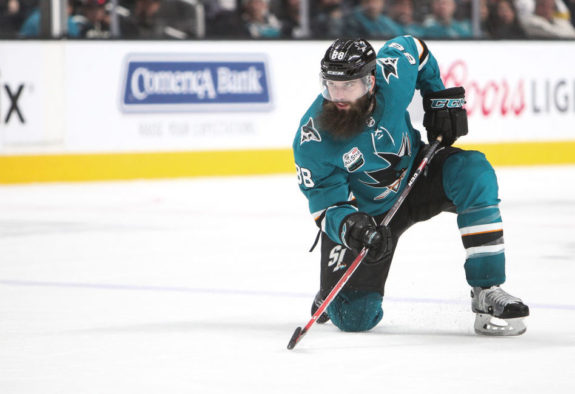
DeBoer’s choice to concentrate his most talented defenders together means he’s likely to lean on them more heavily. Which equates to greater ice time.
Burns, who will soon turn 34, is averaging the identical ice time per-game as he did in his Norris Trophy winning season. Which is also the season he fell apart in the final month. Last season, he was clearly banged up in the playoffs. In each of the last two seasons, he has been a lot better in February than in April. DeBoer can take some risk off the table here by playing him less.
It isn’t just the defensemen, though. The team’s top scoring forwards are also pushing the envelope.
Joe Pavelski, age 34, continues to average the same amount of ice time as he has the past few seasons. He leads the team in goals and has played every game this season. Logan Couture is second on the team in points (behind Burns) and is on-pace for his highest ice time per-game in four seasons. He is also on track to play all 82 games for only the second time in his career. Both players are getting very heavy use.
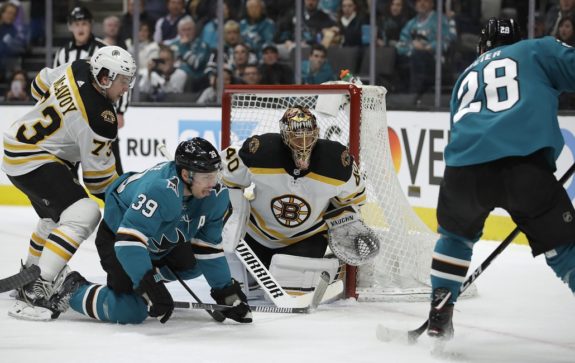
Lest it all go on the wrong side of the ledger, Evander Kane is on track to play all 82 games for the first time in his career. But DeBoer has him playing his fewest minutes per-game since he was 21. Less really can be more.
DeBoer’s Approach
Among Sharks defensemen, Dillon leads the team at plus-20, followed by Burns at plus-13 and Radim Simek at plus-eight. But Dillon’s ice time is just 17 minutes a night, Simek a bit over 15. Meanwhile, four Sharks defensemen top 20 minutes a night and two, Burns and Karlsson, clock in at nearly 25 minutes a night.
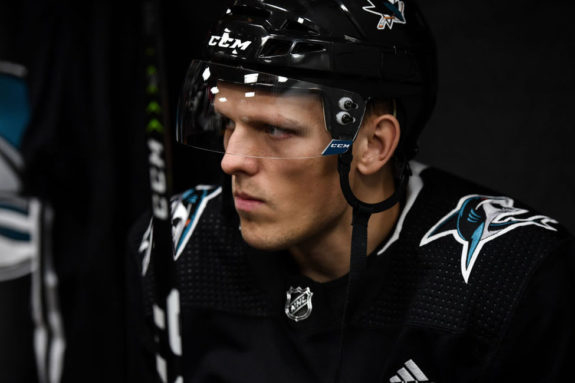
The last three games are noteworthy with Burns. In the 5-1 loss to the Washington Capitals on Valentine’s Day, Burns played 25:35 of ice time. This included an intense shift nearly a minute and a half long beginning with five minutes left in the game. After a television timeout, he returned to the ice for another minute-long shift, which ended when he had his shot blocked and the Caps turned it into an empty-net breakaway score. This is how players burn out, using a lot of energy for hard minutes in an ‘out of reach’ game.
In the next game against Vancouver, Burns was on the ice for 25:52. Against the Boston Bruins, a 6-5 overtime loss on Monday, Burns played 26:46. Against Vancouver, Dillon played just 14:18, Simek just 10:08. Against the Bruins, Dillon played 14:59 and Simek 12:48.
Is DeBoer risking burning out Burns, the team’s leading scorer and most valuable player? Well, yes. Might issues arise with key players like Pavelski and Couture, who are both playing big minutes this season and are seeing those minutes increase? Yes. Are these risks worth taking? Not even close.
The Dylan Gambrell Example
The Sharks have given 22-year-old forward Dylan Gambrell four NHL games this month. I like this move, as it gives the team a chance to see his development. Plus, he’ll have more experience to draw on if he is needed for the playoffs. This is the kind of move which can prove useful. Alas, DeBoer played Gambrell a meager seven minutes a night. Limiting him meant reduced playing time for the fourth line.
Against the Canucks, Barclay Goodrow was on the ice for eight minutes, Melker Karlsson under 10 minutes, well below their average uses. On average, every other Sharks forward had an extra minute of ice time added to their game to compensate for the limited use of the fourth line.
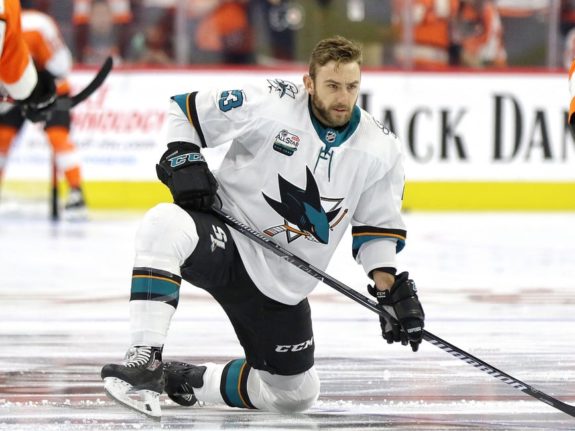
This is the time to take risk off the table. Playing a youngster who might wind up seeing action in the playoffs takes some risk off the table. But DeBoer played him too little. It doesn’t help Gambrell as much as it could and adds ice time to other players – the players the team can’t afford to wear down. This isn’t the right approach.
An Eye on Martin Jones
The Sharks’ top netminder, Martin Jones, is having an awful regular season. To be clear, a great regular season is not required for a Cup run. Just ask the Caps’ Braden Holtby, the Cup-winning goalie last season. Or the Pens’ combo of Matt Murray and Marc-Andre Fleury, from the Cup winner the season before that.
What does correlate to playoff success? Less regular season use. DeBoer must, once again, think things through with Jones. As documented, Stanley Cup winning goalies rarely top 60 games played (it hasn’t happened in any of the last six seasons) and Jones is on his way to topping that figure, aided by playing in all but one of the Sharks’ eight post All-Star Game tilts.
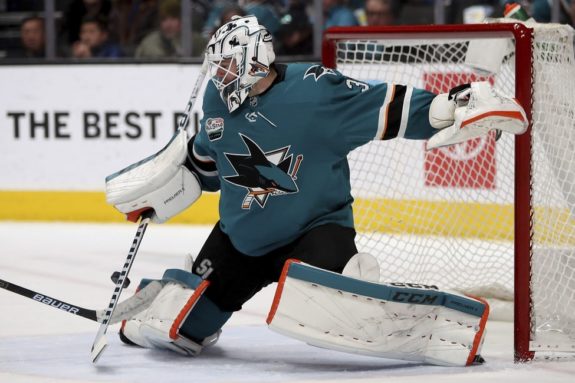
Jones has played in 45/60 games, which projects to 62 for the season. Which history says is too many. Here again, DeBoer is pushing odds which don’t need pushing.
DeBoer’s History Repeats
It is easy to get caught up in thrilling games like the Sharks’ loss to Boston on Monday. A big comeback, some questionable officiating and a Joe Thornton hat trick all created a great atmosphere. In the bigger picture, Thornton’s hat trick is the clearest sign yet that his injury issues of the past two seasons are hopefully behind him.
It is the bigger picture which really is everything. This Sharks season isn’t coming down to a blown call (or three) in a game in February. The season which matters in San Jose does not begin until April.
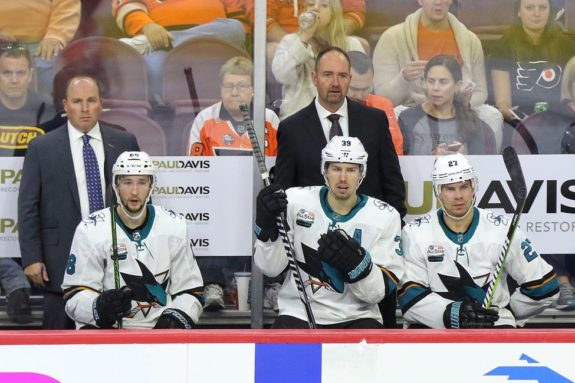
It is time to cut back the minutes of Pavelski, Couture, Burns, Karlsson (who played over 28 minutes against the Bruins) and to a lesser extent, Vlasic. Allow fourth-line players like Gambrell, Goodrow and Lukas Radil more ice time, along with defenders Dillon and Simek. And use the backup goalie, Aaron Dell, a good bit more.
It is time to start dialing in the playoff pairings and lines. Yes, some things will change and there is still experimenting to do. The Sharks have the best defensive pairing in the league with Karlsson and Dillon – DeBoer doesn’t need to experiment here. This is an odd time to abandon an elite pairing in favor of one which hasn’t had great chemistry
DeBoer’s historic mistakes have fallen into two categories, misusing his defensive pairs and burning out his key players. Do his recent moves suggest he’s learned from his prior mistakes? I’m not seeing it.